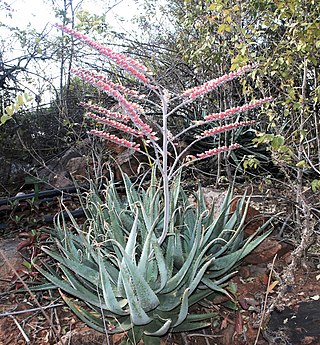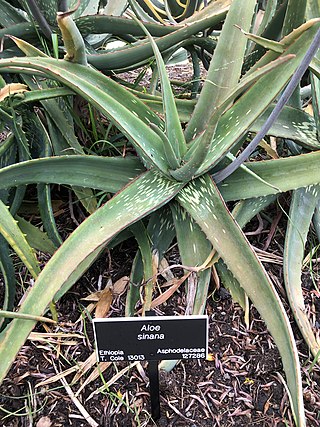
Aloe is a genus containing over 650 species of flowering succulent plants. The most widely known species is Aloe vera, or "true aloe". It is called this because it is cultivated as the standard source for assorted pharmaceutical purposes. Other species, such as Aloe ferox, are also cultivated or harvested from the wild for similar applications.

Gonialoe variegata, also known as tiger aloe and partridge-breasted aloe, is a species of flowering plant in the family Asphodelaceae. It is an evergreen succulent perennial indigenous to South Africa and Namibia. It is common in cultivation.

Aloe marlothii is a large, single-stemmed Southern African aloe of rocky places and open flat country, occasionally growing up to 6 m tall.

Gonialoe dinteri, the Namibian partridge aloe, is a species of flowering plant in the Asphodelaceae family. It is native to arid areas of Angola and Namibia.
Abraham Erasmus van Wyk, also known as Braam van Wyk is a South African plant taxonomist. He has been responsible for the training of a significant percentage of the active plant taxonomists in South Africa and has also produced the first electronic application (app) for the identification of trees in southern Africa.

Inez Clare Verdoorn was a South African botanist and taxonomist, noted for her major revisions of plant families and genera. She is also a niece of Eugene Nielen Marais, lawyer, naturalist, poet and writer.

Illtyd Buller Pole-Evans CMG was a Welsh-born South African botanist. Sometimes his first name is spelled Iltyd.

Aloiampelos striatula, formerly Aloe striatula, the hardy aloe or striped-stemmed aloe, is a sturdy succulent plant that naturally occurs on the summits of mountains along the south of the Karoo region of South Africa. Tough and hardy, with bright yellow flowers, it is also cultivated as a garden ornamental.

Aloiampelos tenuior, formerly Aloe tenuior, the fence aloe, is a bushy, multi-branched succulent plant from the grasslands and thickets of the Eastern Cape, Kwazulu Natal and Mpumalanga, South Africa. Its preferred habitat is sandy soils in open country, unlike many of its relatives that favour thicket vegetation. It is one of the most profusely flowering of all aloes and their relatives.

Aloe rauhii is a rare succulent and highly drought-resistant plant endemic to Madagascar. It is named after Professor Werner Rauh, who was a professor of Botany at the University of Heidelberg in Germany.

Aloe pearsonii is a very distinctive and unusual species of aloe, that is naturally endemic to the arid Richtersveld area on the border between South Africa and Namibia.

Aloe ser. Mitriformes is a taxonomic series within the genus Aloe, comprising several closely related species of Southern African rambling aloe. These typically multi-branched sprawling aloe species have rigid fleshy leaves and slender pedicels about the length of the perianth, each being roughly 40 mm long. The stems tend to sprawl along the ground, with the ends densely leafed and upturned.

Aloe globuligemma, commonly known as the witchdoctor's aloe, is a species of flowering plant in the family Asphodelaceae. It is native to southern Africa where it occurs in semi-desert and dry bushland. It is an evergreen, succulent, perennial plant. The plant forms large, dense clumps. It is harvested from the wild for local medicinal use.

Harry Hall, was a British-born horticulturist, botanist and succulent plant authority.
Harold Basil Christian was a Cape Colony-born Rhodesian farmer, horticulturist, and botanist. Christian attended Eton College in the United Kingdom, where he was a distinguished athlete. He served in the Imperial Light Horse of the British Army during the Second Boer War, during which he fought in the Siege of Ladysmith. In the decade after the war, he worked in what is now South Africa for De Beers and later as an engineer for a mining company. In 1911, Christian moved to Rhodesia. There, he purchased a sizable farm, which he named Ewanrigg. He was best known for his study and cultivation of aloe on his extensive estate, which was donated to the state upon his death and became a national park.

Peter René Oscar Bally was a Swiss botanical illustrator, botanist and taxonomist. The standard author abbreviation P.R.O.Bally is used to indicate this person as the author when citing a botanical name.

Stanley Charles Seagrief was a South African botanist and botanical illustrator, specialising in phycology.
Lucy Katherine (Kathleen) Armitage Chippindall, also known as Chipps and later as Mrs. Albert Oliff Crook was a South African botanist and agrostologist.

Aloe sinana is a succulent plant species from Ethiopia. It is related to Aloe camperi. It is a shrubby Aloe with leaves longer than Aloe camperi and different inflorescence. The flowers are orange-red in color.

















